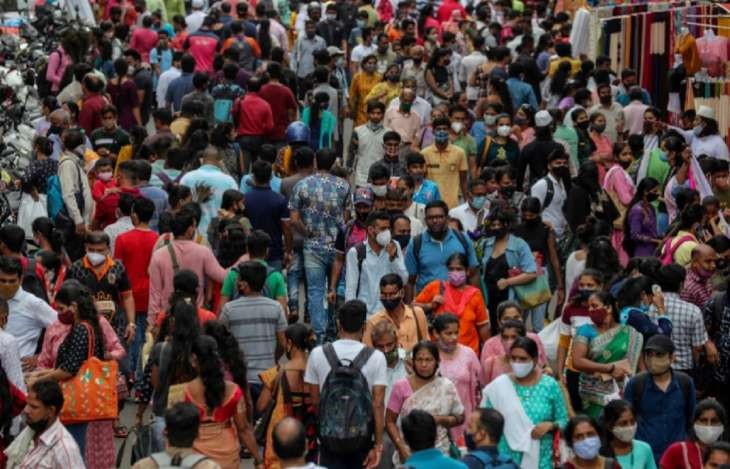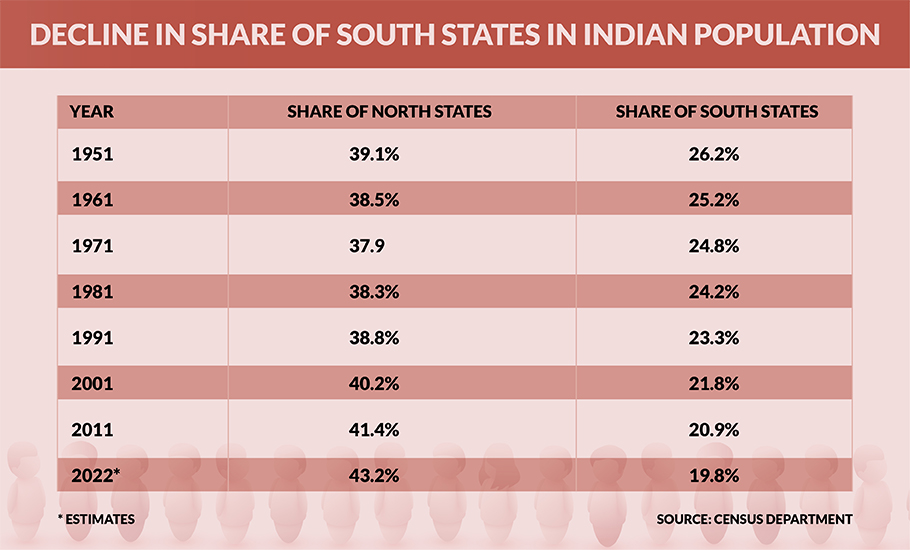
South's share in Indian population lowest in 2022: Census estimates
Since 1951, the share of the population from southern states has been on the decline. From 26.2 per cent in 1951, the percentage dropped to 19.8 per cent in 2022

The share of South states in the Indian population is decreasing as per the 2022 Census estimates. Data released by the Census department recently shows that just 19.8 per cent of the Indian population is from the states of Telangana, Andhra Pradesh, Tamil Nadu, Karnataka, Kerala and Union Territories of Puducherry and Lakshadweep.
This is as compared to the share of the northern states of Uttar Pradesh, Rajasthan, Madhya Pradesh, Bihar, Chhattisgarh and Jharkhand, which is at 43.2 per cent.
 Since 1951, the percentage of the population from the southern states has been declining. While in 1951, it was 26.2 per cent, it has dropped to 19.8 per cent in 2022. The northern states’ percentage, meanwhile, has gone up from 39.1 per cent to 43.2 per cent for the same period.
Since 1951, the percentage of the population from the southern states has been declining. While in 1951, it was 26.2 per cent, it has dropped to 19.8 per cent in 2022. The northern states’ percentage, meanwhile, has gone up from 39.1 per cent to 43.2 per cent for the same period.
Also read: TN gears up for Census exercise though Centre yet to announce dates
Between 2001 and 2002, the southern states population share has declined from 21.8 per cent to 19.8 per cent, while that of northern states has increased from 40.2 per cent to 43.2 per cent.
Population experts say that migration will happen from north to south in search of job opportunities due to the increasing mix of population by the northern states. Cheap supply of unskilled labour from northern states will continue to benefit south as it is today, said a population expert.
“These gains will increase in the future as well as the share of the working-age population increases in the southern states. Cheap workforce also has the potential of triggering social unrest. As migration changes linguistic profiles and puts pressure on employment opportunities for unskilled native workers, discontent is bound to rise,” said the expert.
“The main reason for the declining rate in southern states in the population is better literacy rate, especially among women in these states. This prevents them from giving birth to more than one or two children and their fertility rate is much lower than 2,” said the expert.
Also read: Population growth: Myths, realities and the deeper neglect
Prime Minister Narendra Modi indicated that population explosion may pose challenges to the future generations during his Independence Day speech in 2019.
0-14 years age group lower in South
State-wise data indicates that the share of population in the 0 to 14 years is lower in southern states compared to the rest of the country. In fact, the number has been decreasing for the past few years. Southern states reported a higher share of persons in the working age and senior citizen categories.
For instance, in 2018, the share of population in the 0-14 age group in southern states was between 19.8 per cent in Andhra Pradesh and 23 per cent in Karnataka. The highest such share in Karnataka (23 per cent) is still lower than the national average of 25.9 per cent.
At the same time, the national average share of persons above 60 years of age was 8.1 per cent, while the southern states reported between 8.1 per cent to 12.9 per cent in that age group. Similarly, in the case of the working age group, India reported 66 per cent, while southern states reported between 68.6 per cent and 71.1 per cent, except Karnataka.


